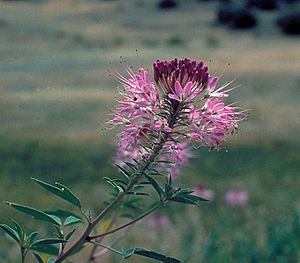Cleome serrulata facts for kids
Quick facts for kids Cleome serrulata |
|
|---|---|
 |
|
| Conservation status | |
| Scientific classification | |
| Genus: |
Cleome
|
| Species: |
serrulata
|
| Synonyms | |
|
Peritoma serrulata DC. |
|
Cleome serrulata is a cool plant often called Rocky Mountain beeplant or stinking-clover. It's also known as bee spider-flower, skunk weed, Navajo spinach, and guaco. This plant is an annual plant, which means it grows, flowers, and produces seeds all in one year.
Lots of insects love this plant, especially bees! Bees help the plant make seeds by moving pollen around. This plant grows naturally in southern Canada and across the western and central United States. People have used it for a long time as food, to make dyes for painting, and even as medicine.
Contents
What's in a Name?
In 1814, a scientist named Frederick Traugott Pursh first described this plant. He found it near the Vermillion River in South Dakota during the famous Lewis and Clark Expedition.
Later, in 1824, another scientist, Augustin Pyramus de Candolle, decided to put this plant in a new group he called Peritoma. So, for a while, its name was Peritoma serrulatum.
But over time, scientists realized that Peritoma serrulata was actually the same plant as Cleome serrulata. So, the original name stuck!
What Does It Look Like?
The Rocky Mountain beeplant is an annual plant that can grow from about 10 centimeters (4 inches) to 1.5 meters (5 feet) tall. Its leaves are arranged in a spiral around the stem. Each leaf has three thin leaflets, which are like small leaves, about 1 to 7 centimeters (0.4 to 2.8 inches) long.
The flowers are really pretty! They can be reddish-purple, pink, or white. Each flower has four petals and six long parts called stamens. These are the parts that hold the pollen.
After the flowers bloom, the plant makes a long, thin seed pod called a capsule. These capsules are about 3 to 6 centimeters (1.2 to 2.4 inches) long and hold many seeds. The plant flowers for a long time because new flowers keep opening from the bottom of the stalk all the way to the top. You can often see both flowers and seed pods on the plant at the same time.
The seeds are dark brown or black, curved, and look a bit bumpy. Once the seeds are scattered, the plant starts to break down. This plant is called waa’ by the Navajo people, tumi by the Hopi people, and a'pilalu or ado:we by the Zuni people.
Where Does It Grow?
You can find Cleome serrulata growing naturally in southern Canada, from British Columbia to Ontario. In the United States, it grows from the west coast all the way east to Ohio and southwest to Texas. It has also spread to other places in North America, like Maine.
This plant often grows in places where the ground has been disturbed, like along roadsides, in open woods, in mountain foothills, and in prairies. It likes moist soil that is light or sandy and a bit alkaline (not too acidic). It can grow in many different soil types and prefers some shade or full sun. It can also handle dry conditions. In the northern Rocky Mountains, it's often found at elevations between 760 and 2200 meters (2,500 to 7,200 feet).
You might see this plant growing alongside other plants like western wheatgrass, bluebunch wheatgrass, prairie Junegrass, Sandberg bluegrass, common gaillardia, big sagebrush, and prairie coneflower.
How People Use It
People in the southwestern United States have used Cleome serrulata for food, medicine, and dye for a very long time, even before history was written down! It's one of the few wild foods still used today.
- As Food: The seeds can be eaten raw or cooked. They can also be dried and ground into a flour to make a mush. The leaves, flowers, and young shoots can be cooked like a vegetable or added to cornmeal porridge. The Zuni people used to gather lots of leaves and hang them indoors to dry for winter. They would cook the young leaves with corn and lots of chili peppers. Sometimes, they would even add pieces of iron or rust to the cooking pot to make it less bitter! Animals usually don't eat this plant because it has a strong taste and smell.
- For Farming: The Tewa and other tribes in the Southwestern United States often planted Cleome serrulata with their corn, beans, and squash. This was part of their "Three Sisters" farming method. The beeplant was like a "fourth sister" because it attracted bees, which helped pollinate the beans and squash.
- As Medicine: In traditional Native American medicine, a special tea made from the plant was used to help with stomach problems and fevers. Pastes made from the plant could also be put on the eyes.
- As Dye: The plant can be boiled down until it becomes a thick, black syrup. This syrup was used as a binder (something that holds things together) in paints for black-on-white pottery by the Ancestral Puebloans as far back as 900 to 1300 years ago. The Navajo still use it today to make a yellow-green dye for their beautiful rugs and blankets. The plant paste is also used with black mineral paint to color sticks for special offerings.
Plant Life
The flowers of the Rocky Mountain beeplant are very popular with many different kinds of pollinators, like bees and butterflies. It's also a host plant for the checkered white butterfly, which means the butterfly lays its eggs on this plant, and the caterpillars eat its leaves.
Gallery






